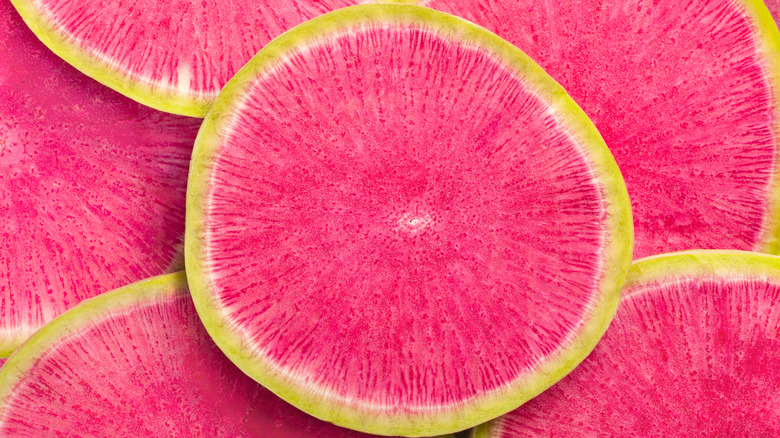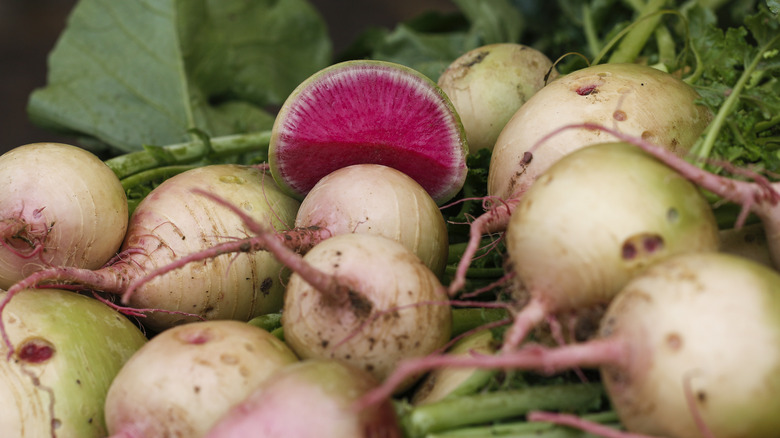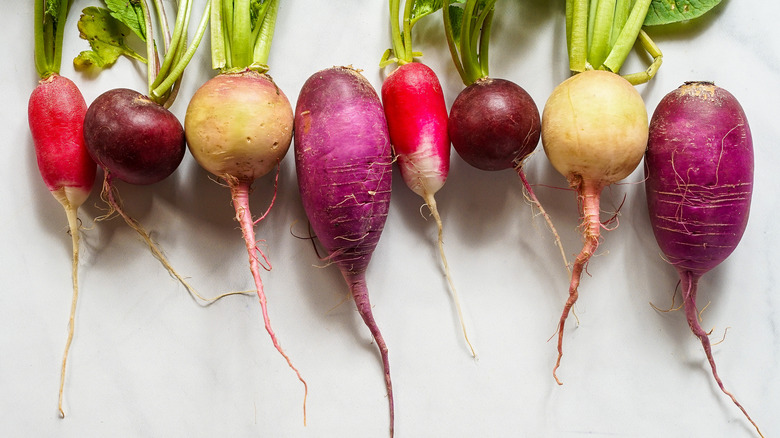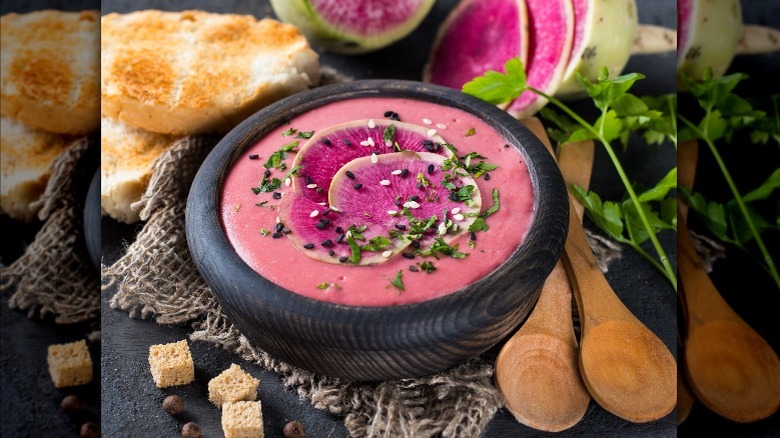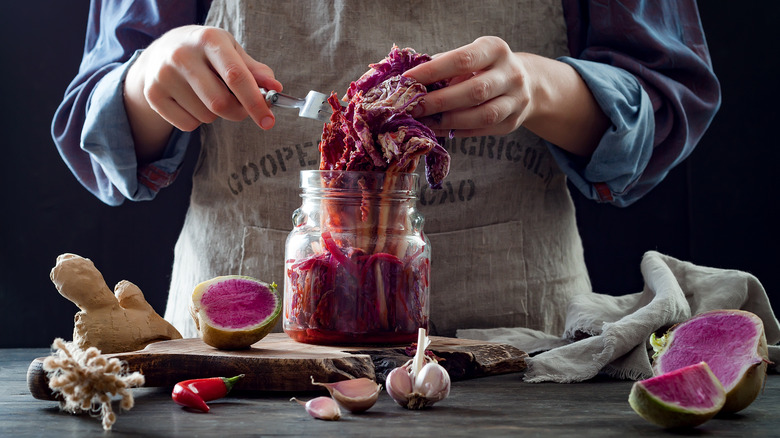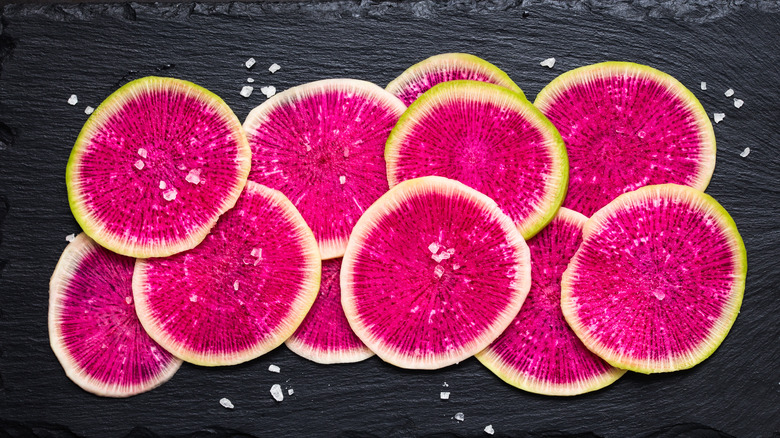Watermelon Radishes Are A Stunning Addition To Almost Any Dish
The striking appearance and mildly piquant flavor of the watermelon radish have earned the vibrant veggie a specialty status on the plate and palate. According to Specialty Produce, watermelon radishes are native to China and aptly named "shinrimei," which means "beautiful heart." It's a perfect descriptor for the root vegetable disguised as a drab radish that reveals a stunning pink interior when cut. From its presentation to its flavor profile, the watermelon radish really packs a punch.
Hailing from the Brassicaceae family, the watermelon radish (Raphanus sativus) has a milky white skin surrounding a bright green layer of flesh encompassing a streaked fuchsia interior, similar to the color variations within a watermelon. It is related to the sweet summer fruit in appearance only and shares a peppery, cruciferous flavor profile akin to broccoli, arugula, and rutabagas from the same mustard family of edible plants (per Britannica).
Being easy on the eyes is hardly the only thing that this visually appealing vegetable has going for it. Watermelon radishes also straddle a unique flavor profile that is somehow mild yet spicy all at once.
Origins of the watermelon radish
There's a legitimate interest within the culinary community regarding heirloom varietals of common fruits and vegetables that have created a culture of foodies and chefs vigilantly searching the local farmer's market and produce purveyors for specialty foods. Martha Stewart describes heirloom plants as varieties grown from seeds that have not been subjected to controlled pollination resulting in an organic entity with origins dating back 50 years at a minimum. There's been a rejuvenated interest in specialized produce over the past few decades for good reason, as heirloom foods often feature intensified characteristics bred out of commonplace produce.
According to Mother Earth News, the humble radish originated in Asia, with ancient texts and excavation discoveries rooting the vegetable in Northern China. Many varieties of radishes emerged, naturally cultivated to suit their growing environment, and began to make their way across the globe along with humans as migration and trade increased. These hearty vegetables evolved many shapes, colors, and sizes, ranging from large, round salmon-colored bulbs to long, red oval shapes to small, deep purple varieties.
The watermelon radish is one such heirloom variety that The Chef's Garden links to the well-known Chinese daikon radish. After its debut in the West, it quickly gained popularity for its adaptability, desirable crunchy texture, and refreshingly piquant flavor profile. A favorite of chefs, the watermelon radish became a go-to vegetable option that amplified and balanced many dishes with its unique taste and vibrant color.
Grow your own
Beloved for its brightly colored interior and approachable flavor, the watermelon radish is also easy to grow. Gardening Know How notes that because of its heirloom status, it can be difficult to find seeds at the store. Seed stock can be found online or at specialty nurseries, and the extra effort is worth the result. Watermelon radishes make a unique addition to your edible garden.
This hearty, cold-weather vegetable grows best when seeds are planted in soil that has reached a minimum of 40 degrees Fahrenheit, ideally around mid-spring. Watermelon radishes prefer to be planted about two inches apart in richly composted, well-draining soil that gets watered often without overdoing it.
According to Balcony Garden Web, you don't have to have an extensive vegetable garden to grow delicious radishes, and they do great in a simple container that's deep enough to allow the bulbs to develop under the well-watered soil. Whether you have a bed or a balcony, ensure that your radish garden is getting plenty of sun to help the bulbs grow to the correct size and texture you expect.
You know it's time to harvest when the "shoulders" of the radish begin peeking out of the soil, about 65 days after planting. If you sow your watermelon radish seeds in two-week increments, you can enjoy a consistent crop well into the fall or year-round in certain climates.
Varieties and flavor profile
Although the watermelon radish shares some flavor attributes with the closely related daikon, Specialty Produce notes that it maintains a mildly spicy and slightly sweet flavor that's all its own. Picking up characteristics from the mustard family (Brassica) to which it belongs, this eye-catching root vegetable features peppery notes similar to that of arugula that extend into their leafy green tops. When grown in cold climate zones, watermelon radishes yield a more subtle flavor with a luscious mouth feel.
When grown in warmer areas, the lovely root vegetable often develops a spicier flavor with a drier texture. While comparable to other radish varieties in texture and subtle piquant flavor notes, watermelon radishes often have a larger bulb (up to the size of a softball) that contains most of the spicy flavor associated with the root veggie. As it grows larger, its flavor becomes more subtle.
According to Chef Works, watermelon radishes have a milder flavor in comparison to the familiar red radish that features more intense notes of pepper. They have a mildly sweet, vegetal taste that strikes a delicious balance with their earthy, delicately piquant essence. When you want a succulent vegetable featuring a harmonious spicy-sweet taste rooted in subtle flavors, reach for a watermelon radish.
Cooking with watermelon radishes
Cooking with radishes adds a unique taste to many meals, and the piquant yet neutral flavor, astounding color, and snappy texture of the watermelon radish make it a welcome addition to a variety of dishes. According to Specialty Produce, this versatile radish can be served raw or pickled but also stands up to roasting, sautéing, and simmering. Prep is easy, as watermelon radishes don't have to be peeled before eating.
MasterClass recommends pickling radishes in the vinegar and spice combination of your choice to impart tangy flavors that saturate the mild vegetable and make a zesty topping for rich tacos or delicate seafood. Roasting watermelon radishes enhances the mild sweetness of the veggie and tastes best with a simple coating in olive oil seasoned with salt and pepper.
Watermelon radishes truly shine in their natural, raw state, as cooking them can somewhat compromise the snappy texture and vibrant pink color that we are all here for in the first place. Its peppery flavor, craveable crunch, and show-stopping colors are front and center in a watermelon radish slaw or salad, especially when enhanced by earthy greens, tangy cheeses, or a spicy dressing. They can be thinly sliced on Radish Toast or delicate sandwiches and tucked into sushi rolls for a pop of color and flavor (via Specialty Produce). Watermelon radishes can be used as a colorful garnish or tasty side dish but are hearty and flavorful enough to make a stunning entrée.
Tips for buying and storing
When roaming around the radish section of the produce department, Food52 offers a few tips for selecting the freshest watermelon radishes. Remember that watermelon radishes are much bigger than the golf ball-sized red varieties and are generally larger and heavier, similar in size to a turnip. They should have a solid heft to them when handled, and their creamy white-green skin should be tight and unblemished. When squeezed, a good watermelon radish should be unyielding, indicating an uncompromised interior that will have a succulent, crunchy texture.
There are a few effective methods for storing radishes so you can enjoy them in multiple dishes for up to a month or longer. Since watermelon radishes are considered cold-weather vegetables, they keep well in cool places like your fridge's crisper drawer for about a month or a cold cellar for up to three months (via MasterClass). Keep them fresh by cleaning them and placing them in a food storage bag or container, or you can store them in the refrigerator covered in cold water. Alternatively, extra watermelon radishes can be pickled to extend shelf life or blanched and frozen for later use.
Nutritional benefits
Watermelon radishes are more than cruciferous vegetables that are easy on the eyes; this radish boasts vivid hues that are matched by its dynamic health benefits. Everything Radish notes that this heirloom varietal is a high-fiber, low-calorie food teeming with antioxidants and essential nutrients like vitamin C, magnesium, calcium, and potassium.
The vitamin and mineral content of the watermelon radish contribute to immune health and can ward off illnesses along with aiding in speedy recovery from common colds and flu. They fill you up without weighing you down and aid in digestion through their fiber content that helps move toxins and infections out of your system.
Watermelon radish's calcium content may help maintain bone density while alleviating some joint pain and inflammation. Its notable potassium levels improve muscle and nerve health, while the radish's impressive water content (about 90%) improves kidney function by hydrating the body.
Known as the "beauty heart" for good reason, the watermelon radish is a stunning vegetable that looks as good as it tastes and benefits the body while pleasing the palate.

